The MFA Show does not have a single unifying theme. The gallery’s walls do not feature labels explaining the thematic groupings that the 12 student curators have arranged after numerous studio visits and conversations with the pool of 119 graduating artists. Since this process of curating the MFA Show remains largely obscured in its display, can an all-encompassing curatorial statement on the exhibition be written without merely documenting the process, its challenges and limitations?
We have seen how curators organizing exhibitions of a similar scale—biennials, triennials or quinquennials—create sprawling concepts within which they can absorb diverse artists or reject specificity altogether.[1] Following such long-established models, I propose that there are many modes of viewing the MFA Show, that there are many curatorial statements to be written.
Curating emerges from the mind’s capacity to weave stories. Without providing a stated conceptual framework, the MFA Show relies on the attentiveness of the viewer against the ambivalence of the exhibition’s cohesion. The viewer may organize the artworks in the show into thematic groupings, let some slip out of the narrative, let them separate from each other, or collide into chaos. Viewing this culmination of a two-year pedagogical program, I suggest, is an exercise in writing.
Here, I present three of potentially infinite curatorial statements for the MFA Show, inviting you to write your own. In a way, these exhibitions are taking place in the Sullivan Galleries throughout the duration of the MFA Show.
Proposition 1 of infinite
Title: Surface Tension
Artists: Jaclyn Mednicov, Bert Geyer
The impulse of mark-making precedes language, the means with which we categorise images as art. In retroactively building the framework to assign value to acts of creation, the historian expects a suspension of disbelief in order to extend the capacities of the imagination of the present into the past. To frame the origin of art in mark-making then is to accept its multivalence—as trace, testimony, document, memory.
Jaclyn Mednicov photographs graffiti carved into the cement pathways of Chicago’s lakefront. Transferring these traces of personal affect onto prints on carpet, Mednicov mines acts of vandalism for poetry. April 16, 2016 – May 19, 2016, Mednicov’s ephemeral memorial for the graduation show, features walls layered with paint, gold leaf, fresh flowers, and moving images, considering the subtraction and addition of material as a painterly gesture.
Bert Geyer draws attention to the structures of objects and monuments, deconstructing them to investigate what lies below the surface. Inciting a latent fluorescence presents the artist in a historic wooden alleyway in Chicago, planing its surface under UV light to bring out the material’s natural fluorescent properties. Geyer’s actions, recorded on video, oscillate between vandalism and preservation, transforming what we take as fixed and constant, disrupting the basis on which it is deemed to have value.
Proposition 2 of infinite
Title: Ear to the Ground
Artists: April Martin, Elizabeth Van Loan, Cathy Hsiao, Anna Orlikowska
Before it was possible to play recorded sound, French inventor Édouard-Léon Scott de Martinville captured a fragment of Au clair de la lune on a sooty paper on the 9th of April 1860. Léon Scott’s phonautograph rendered sound into a visual artefact—to hear it one had to read to an abstract drawing.
Treating listening as an expanded practice, April Martin, Elizabeth Van Loan, Cathy Hsiao and Anna Orlikowska present material investigations that collapse looking and recording. Martin’s cyanotype moves periodically as it records sunlight streaming through the historic façade of the Sullivan Center, at intervals filtered by the artist’s copper blinds; Van Loan’s wooden box leans against the wall filled with water to the brim, its presence invisible yet affective; Orlikowska’s performance of listening to a large wooden funnel plays on a video while its remnant, the object itself, lays silent; Hsiao’s recorder gathers sounds of the exhibition passing through her delicate wooden arches.
The artists collectively consider mediation in making, staging and viewing.
Proposition 3 of infinite
Title: Seeing Double
Artists: Gary LaPointe Jr., Christine Han, Kierstin Siegl
“…vision is attached to movement. We see only what we look at. What would vision be without eye movement? And how could the movement of the eyes not blur things if movement were blind? If it were only a reflex? If it did not have its antennae, its clairvoyance? If vision were not prefigured in it?
My movement is not a decision made by the mind, an absolute doing which would decree, from the depths of a subjective retreat, some change of place miraculously executed in extended space. It is the natural sequel to, and maturat10n of, vision. I say of a thing that it is moved; but my body moves itself; my movement is self-moved. It is not ignorance of self, blind to itself; it radiates from a self…”
Maurice Merleau-Ponty, “Eye and Mind,” 1964
We see the world through doubling. The eye apprehends an object only when its existence is mirrored on the retina. The movement of the body is implicated in the functioning of vision, in creating the residue of an object as afterimage. Gary LaPointe Jr., Kierstin Siegl and Christine Han deploy materials, methods and images that address sight, mirroring and reflection.
LaPointe’s decommissioned solar panels, mounted on a corner of a wall, no longer serve the function of trapping light to transform it into energy. The panels face away from the window and reflect the objects and structures in their field of vision. Two manhole covers, placed on the floor, feature rims polished into looping reflective surfaces that distort the scale of the corporeal and reflected self. LaPointe turns objects from our daily landscape into mirrors for attentive and distracted bodies moving within an institution.
Han’s paintings depict environments in which sight is filtered through objects. Window blinds that divide the inside from the outside invite contemplation on her canvases. The works freeze moments when attention slows down, underscoring the imperceptible movement of staying still.
Siegl’s sculptures, a table and a peg rail, are based on designs of Shaker furniture. They mimic craft traditions emerging from the call of inner spiritual vision. Alongside these objects, Siegl displays daily horoscopes, weather forecasts and stock market predictions, pointing to the human desire to look into a realm that doesn’t yet exist. On the table, Siegl has placed a fabricated copper penny, camouflaged with the tint of the wood, one of its two faces obscured, our ability to contain it within our vision thwarted.
The MFA Show is on view at the Sullivan Galleries through May 18.
[1] Okwui Enwezor’s 56th Venice Biennale (2015) was centered on the theme “All the World’s Futures,” while Carolyn Christov-Bakargeiv’s documenta 13 (2012) eschewed an overarching concept to present the central exhibition as an organism.


